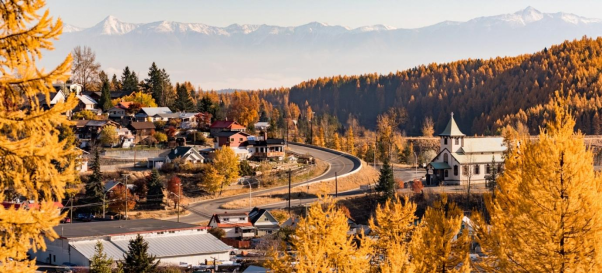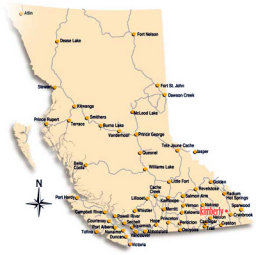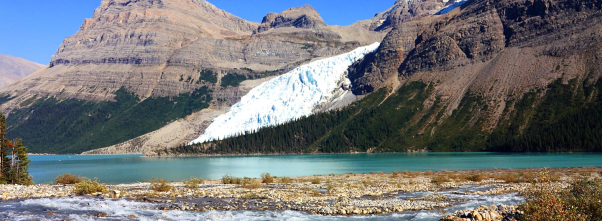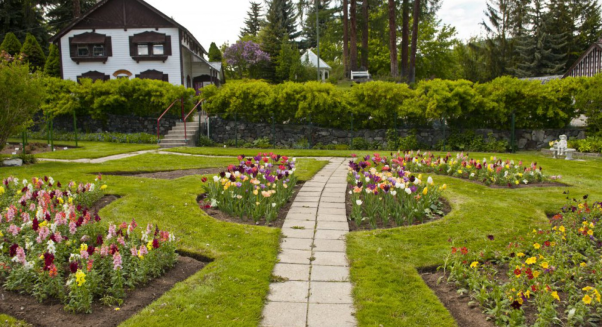Kimberley, British Columbia 作者: 来源: 发布时间:2021-05-25
I.Population and Area
₋Area
Land: 60.62 km2 (23.41 sq mi)
₋Population (2016)
Total: 7,425
Density: 122.5/km2 (317/sq mi)

II.Natural Geography
₋Kimberley is a city in southeast British Columbia, Canada along Highway 95A between the Purcell and Rocky Mountains. Kimberley was named in 1896 after the Kimberley mine in South Africa. From 1917 to 2001, it was the home to the world's largest lead-zinc mine, the Sullivan Mine. Now it is mainly a tourist destination and home to the Kimberley Alpine Resort, a ski area and Kimberley's Underground Mining Railway that features a 750-foot-long (230 m) underground mining interpretive centre complete with operational 3 ft (914 mm) narrow-gauge railway equipment. Recreational pursuits include world-class skiing, snowboarding, snowmobiling, fishing, whitewater rafting, kayaking, biking, hiking and golfing on championship golf courses. The city has the largest urban park i n Canada. At 1,977 acres (800 ha), the Kimberley Nature Park is the largest incorporated park in Canada.
₋SunMine, the largest solar PV plant in Western Canada, was built in 2015 on the site of the former Sullivan Mine concentrator

III.ECONOMY
₋In Kimberley, BC, the median household income is $67,072 per year. The median household income in Kimberley, BC is lower than the national household median income in 2015.
₋The median income indicates the income bracket separating the income earners into two halves of equal size.
₋Website: https://townfolio.co/bc/kimberley/demographics#:~:text=In%20Kimberley%2C%20BC%2C%20the%20median,household%20median%20income%20in%202015.
IV.Industrial Characteristics
₋Light industry opportunities in Kimberley:
1. Manufactured wood products
2. Auto repair
3. Custom fabrication, including metalwork
4. Environmental products
5. Food processing
6. Small-scale manufacturing or service commercial industries in support of regional resource industries (mining, forestry) or tourism (skiing, fishing, golfing)
₋Website: https://kimberley.civicweb.net/document/417
V.Attractions
1.Wasa Lake Provincial Park

₋A family vacation destination since the 1950s, Wasa Lake village advertises the warmest swimming lake in the Kootenays. Wasa Lake Park offers camping, swimming, hiking, cycling, boating and nature viewing opportunities. There is an 8 km wheelchair and bike accessible trail around the lakeshore and a 2.7 km self-guided interpretation trail.
₋World class attractions such as Fort Steele Heritage town, guest ranches, ski hills and golf courses are nearby. In addition to being a popular recreation spot, the park protects a representative grassland ecosystem. It includes a portion of North America’s most northern ponderosa pine forest set amid blue bunch wheatgrass meadows that provide habitat for a wide diversity of animals and plants.
₋History: Wasa Lake Provincial Park was established in 1955 to provide recreational access to the warmest swimming lake in the Kootenays. The Wasa area was logged by the railway in the early 1900s and irrigated for years through a ditch and flume system begun in 1915. Later cattle ranching became the agricultural mainstay. Wasa village provides tourist facilities and services.
₋Conservation: Wasa Lake Park is situated in the gentle terrain of the widening Rocky Mountain Trench. This 144 hectare park protects a representative area of the most threatened ecosystem type in the world; fire maintained temperate grasslands. Of the seemingly endless ocean of native grasslands that greeted the early settlers to our country, less than 5% remains and only a fraction is protected. These bunchgrass meadows host unique species such as curlews and sharp tailed grouse. During June and July, enjoy a spectacular diversity of wildflowers and birds. Intensive grassland restoration is occurring on two land blocks within this park.
₋Website: http://bcparks.ca/explore/parkpgs/wasa_lk/
2.Kimberley's Underground Mining Railway

₋Nestled in the Rocky Mountain Trench in the East Kootenay Region of B.C. is the City of Kimberley; the home of the historic Sullivan Mine and the Underground Mining Railway. The Kimberley Underground Mining Railway is owned and operated by the Sullivan Mine and Railway Historical Society. The Kimberley mining railway has been in existence, in one form or another, for 28 years and has developed into a unique tourist attraction.
₋Join our Mining Tour and ride the rails through the beautiful Mark Creek valley as you listen to the history of Kimberley and the Sullivan Mine. Learn about life as a miner at the Underground Interpretive Centre as our miner guide describes hard rock mining and demonstrates some of the equipment used in the Sullivan Mine. Join us for a short walk to the Sullivan Mine Powerhouse for a guided tour featuring the huge compressors and generators that powered the mine. Board the train again to learn more about Kimberley and enjoy spectacular scenery and glimpses of the occasional wild life as you travel back to the station.
₋The Sullivan Mine & Railway Historical Society is a non-profit organization formed by the merger of the Sullivan Mine Interpretive Centre Society and the Bavarian City Mining Railway Society. The railway originated with the idea of having a commuter train route from downtown Kimberley to the ski hill. In 1978 the Kimberley Steam Railway and Navigation Society was formed by a few men of vision who went to an abandoned mine at Salmo B.C. to obtain rails for the new project. By July, 1984, the railway, named the Bavarian City Mining Railway, was operational and had a ridership of 4,681 passengers. The route consisted of a 2 kilometer track, which circled the Happy Hans Campground.
₋In 1995 the railway line was extended by five kilometres winding down the mountainside and through the Mark Creek Valley to the Downtown Station.
₋In 2004 the extension to the Kimberley Alpine Resort was completed.
₋In October, 2005, the immense undertaking of drilling a 750-foot tunnel was begun. This tunnel is located in the Mark Creek Valley and houses the Sullivan Mine Interpretive Centre. This project was jointly funded by the Canada/British Columbia Infrastructure Program and by Teck Cominco Ltd. The tunnel excavation was done by very experienced former Sullivan miners employed by Redding Mining of Kimberley.
₋In 2006, the BCMR volunteers constructed a new locomotive and three new railcars. During the fall of 2006 the final preparation of the railbed, laying of the rails, and construction of the underground facilities were completed.
₋An official opening ceremony was held prior to the May 19 start of the 2007 tourist season. with many dignitaries from Teck and from all three levels of government in attendance as well as members of the media, our dedicated volunteers and interested Kimberley residents.
₋In 2009 the train could no longer go up to the resort as a Convention Centre was being built where our loading ramp had been. With a focus more on history, a loop route through the tunnel and circling back across from the original portal was constructed and a tour of the Powerhouse was included in the train tours. An Express train trip was added on Saturday, Sunday and Holiday Monday mornings at 10:00 a.m. for those who just like to ride the train. A new loci was purchased and our volunteers revamped it to meet our requirements. The track to the resort was rebuilt and a new Resort Station constructed.
₋Address: 111 Gerry Sorensen Way, Kimberley, BC V1A 2Y5
₋Phone: (250) 427-7365
₋Website: https://kimberleysundergroundminingrailway.ca/our-history/
3.Cominco Gardens

₋With a stunning view of the valley and surrounded by natural trees, Cominco Gardens is a 5 hectare property that boasts over 45,000 flowers annually and is free to visit.
₋Located only minutes from downtown, adjacent to the Kimberley Health Care Centre in Kimberley's Townsite area, the gardens are a popular site for a picnic or casual stroll.
₋Cominco Gardens was originally built to showcase the Elephant Brand Fertilizer which Cominco Mine produced.
₋Address: 290 Rossland Blvd, Kimberley, BC V1A 2R6
₋Phone: (250) 427-2293
₋Website: https://www.tourismkimberley.com/attractions/cominco-gardens
VI.History
₋A gentleman by the name of William Ridpath. a spokane lawyer invested heavily in several Kootenay mining ventures and was among one of the first backers of the fabulous LeRoi Mine at Rossland. Ridpath was said to have renamed a huddle of tents at Mark Creek Crossing because he hoped the camp would have the same luck as the South African centre "Kimberley." Ridpath was to have said to have paid $24,000 for the Sullivan. There was also a tale of a Mr McArthur who grubstaked with Mr. Pat Sullivan who apparently was said to have died three years earlier. Being one of the four men who discovered the Sullivan Mine he stated that he woke up and counted a dozen tents back in 1892. They had made an important discovery then and there was where he picked up a piece of a wooden box and wrote "Kimberley Camp" on it and nailed in on a tree beside the fire.
₋The North Star Hotel was built and the owner was Harry Drew. Drew owned the hotel from 1898 to 1910, and was quite a character. People said he was the most colorful man to move into the area at the time. In his hotel the saloon section never closed its doors and it ran 24 hours a day with three shifts of barkeeps. Harry Webster Drew studied law and self defense back in Boston where he grew up. He worked out as a sparring partner for such men as James J Jeifries who became the world’s heavyweight champion and Tom Sharkley. When he had to handle roughnecks, a class that seemed to patronize saloons in that era his fists could tell a story. At the saloon you could play slot machines, both mills big six and the dime jackpot type, plus poker, blackjack and dice games ran full blast. Harry Drew stood 6 foot tall and weighed about 190 lbs. wore a large mustache, drove a Cadillac and was well respected. Legend has it that when he moved from Boston he was friends with a Mr. Stoper who owned a hotel in High River. Alberta. They moved the hotel from High River to Cranbrook when the railway came through and rebuilt on Baker Street in Cranbrook to be known as "The Manitoba." In the meantime with the discovery of the Northstar and the Sullivan properties Drew and Stoper moved to Kimberley and built the Northstar Hotel. Harry Drew lived a life of riley until prohibition came in. Leaving him with a stake to the value of $5000.00 and his doors closed to the public. This broke his heart. Drew then moved to the coast where in a few short years he died of just that.
₋Prospectors Ed Smith, John Cleaver, Pat Sullivan and Walter Burchett who are now peacefully resting at the St. Mary’s Mission, were gathering supplies after a very rugged overland trip from Kootenay Lake and decided to stop and see the finds at the North Star. They couldn’t - believe what lay betore them - rich ore lay in cuts on the surtace. With great enthusiasm and excitement the men then set out to explore the slope on the other side of the creek. Pat and Ed went along the creek while Walter picked up a piece of "float" and to his amazement noticed a great rust stain "ORE?’ And this was the discovery that built Kimberley into a town. Unfortunately only in Walter Burchett’s later years did he learn the tremendous extent of the discovery. The others died without really knowing their find was to become "the big one."
₋Kimberley became a small mining town and for the most part the activity was high on the top of Sullivan Hill and across Mark Creek at the North Star. An aerial tramway was built to carry the ore on the North Star, earlier on the ore was raw-hided down the mountain by horses. There were no fancy buildings at this time as that was a huge expense in those days.
₋In 1917 there were four or five stores in Kimberley proper and a bunkhouse and cookhouse were built by the 3900 level of the Sullivan Mine and was used as a temporary hospital during the Spanish flu epidemic which was disastrous. The flu killed 25 to 30 million people throughout the world. It was the most deadly epidemic of the 20th century. Even the Stanley Cup finals were cancelled. Joe Hall of The Montreal Canadians died of the deadly flu. More than 3,000 people in BC also died.
₋Website: https://www.electriccanadian.com/canada/history.htm
VII.Other Information
₋Infrastructure
₋Kimberley will receive $72,500 in BikeBC funding for the Kimberley Downtown Trails Connectivity project, creating a safe, accessible multi-use path connecting the downtown to the Peaks to Platzl trail head.
₋“Residents and visitors will take advantage of cycling and pedestrian paths if they provide opportunities to travel on safe, continuous and connected trails and paths,” said Minister of Transportation and Infrastructure Todd Stone. “This new multi-use path will increase access to Kimberley’s paved trail system by creating a key link to existing trails, and will create economic benefits for the community.”
₋The project will link downtown Kimberley to the paved section of the Peak to Platzl trail with a multi-use, separated pathway and a timber-frame bridge across Mark Creek. The Peaks to Platzl trail runs from the north side of Mark Creek to the base of the Kimberley Alpine Resort.
₋This project is part of $9.25 million in funding this year for cycling infrastructure projects throughout the province, including bike lanes, multi-use trails and improvements to roads and highways to improve the safety of cyclists. Through B.C. on the Move, the government’s 10-year transportation plan, the ministry now has committed $20 million over three years to the BikeBC program.
₋BikeBC is the Province’s cost-sharing program that helps communities build cycling projects that attract and support commuter and tourism cyclists. Since 2001, the Government of B.C. has invested more than $230 million in cycling grants and infrastructure.
VIII.Contact Information
₋Government
Mayor: Don McCormick
₋City Hall
₋Address:
340 Spokane Street
Kimberley, BC. V1A 2E8
₋Phone: 250.427.5311
₋Fax: 250.427.5252
₋Info@kimberley.ca(link sends e-mail)
₋Office Hours: 8:30 a.m. to 4:45 p.m. Monday to Friday
₋Closed Statutory Holidays
₋Website: https://www.kimberley.ca/contact
